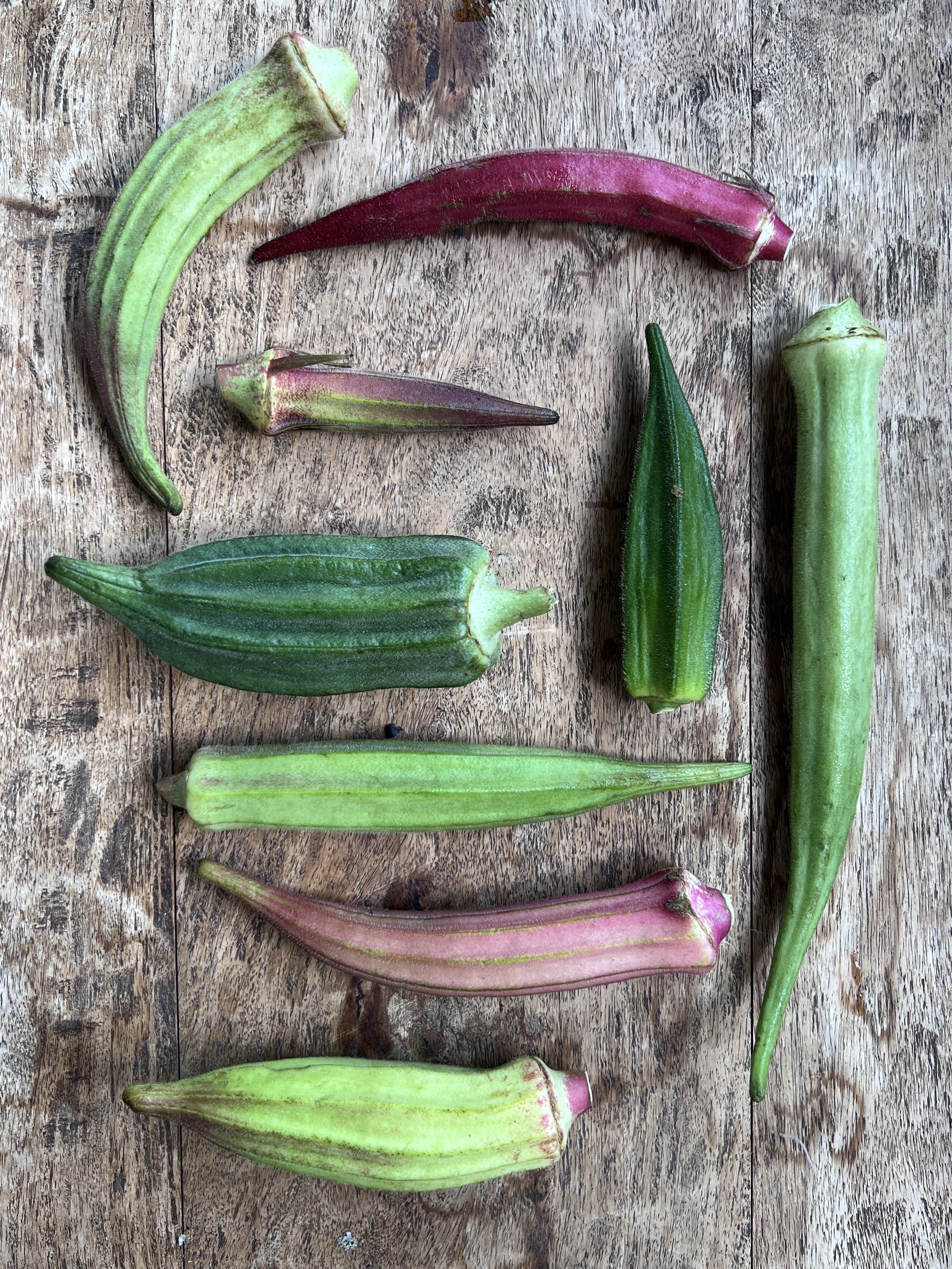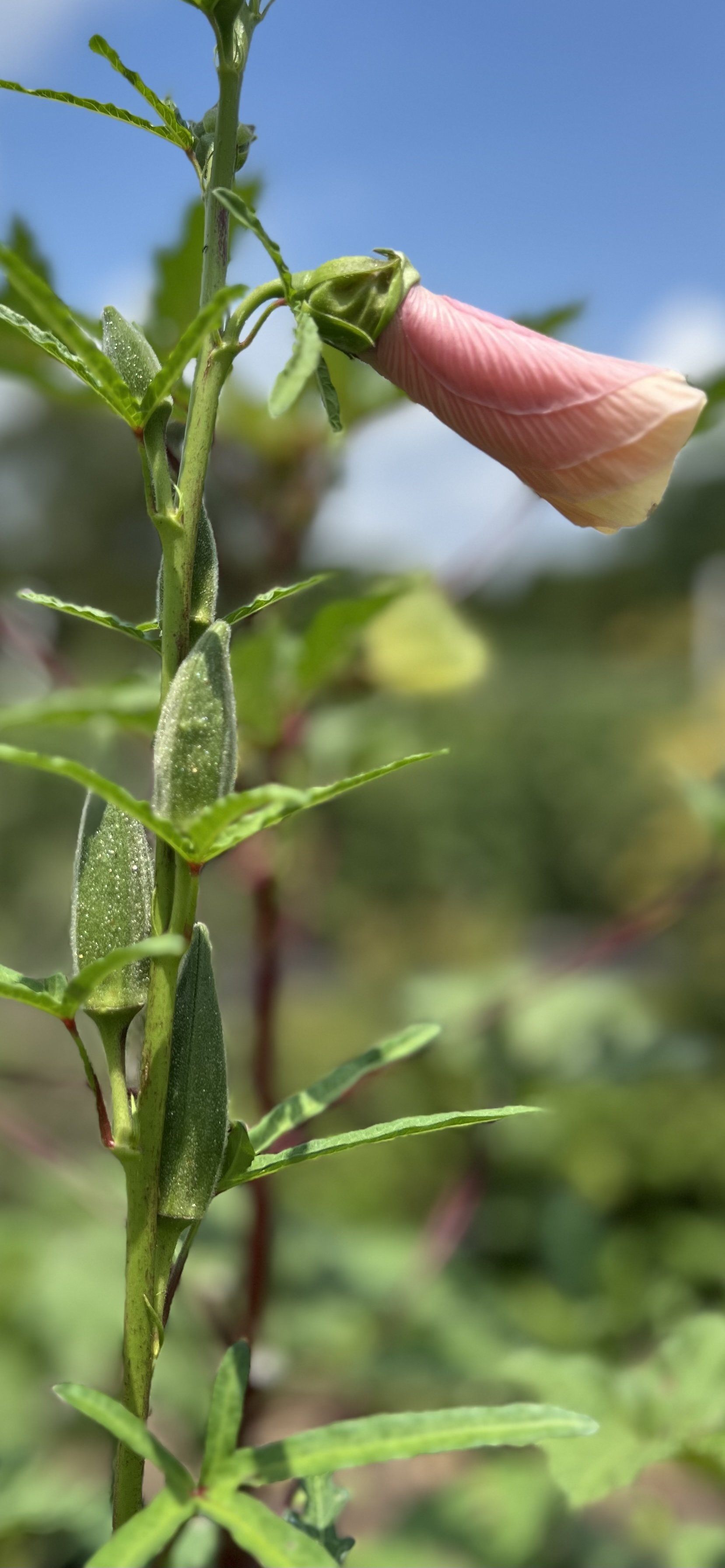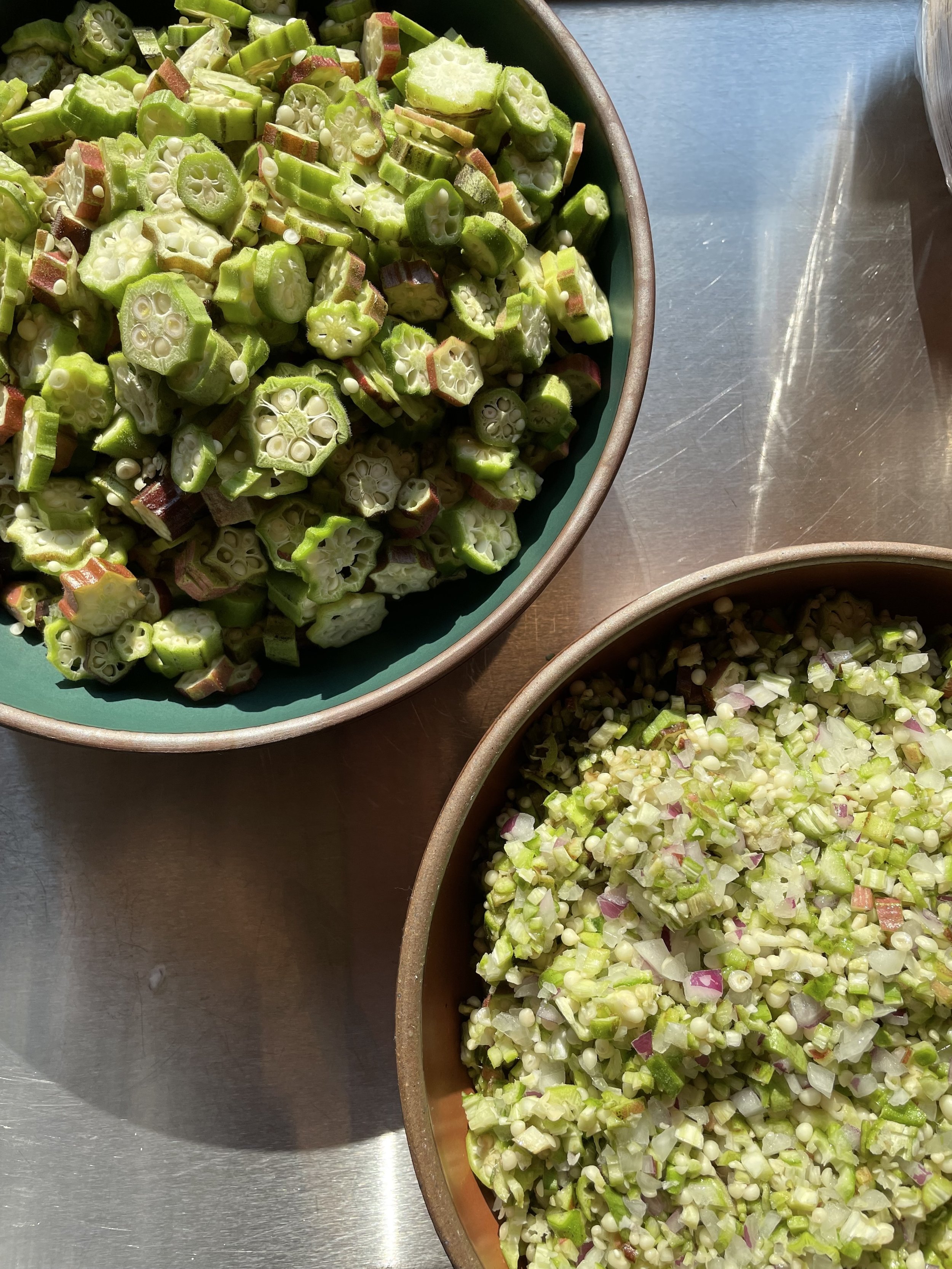
Meet The Chef
Adé Carrena, Dounou Cuisine
When Adé Carrena first came to visit the farm earlier this year, we walked through the gardens and talked about our favorite crops. At the mention of okra her eyes immediately lit up. “Okra is such a special thing to me. My mom made okra stew growing up.” Adé was born in Bénin, a small country just west of Nigeria where okra is a staple. She was raised there until she was ten, before immigrating to the United States.
As an adult, Adé has developed her career as a chef using food to build a bridge between her lived experience as an adopted black woman in the US and her memories of home as a child in West Africa. Through her pop-up dinners, hosted across the Triangle under the mantle Dounou Cuisine, she builds menus that tell stories about this journey and the connective tissue, as well as the paradoxes, between her two homes. She also has a spice company, iLeWA Foods, in which she sources spices from female farmers in West Africa for two distinctive spice blends.
Okra is an apt vehicle for sharing the beauty and the pain of Adé’s migration experience. Its deep roots in West Africa and its foothold in Southeastern United States share a connected history. The plant first arrived to this region during the transatlantic slave trade, departing from the shores of West Africa on the same ships that were full of enslaved humans. Many of the okra recipes that we think of as Southern have evolved from the foodways and cooking traditions of these enslaved populations who were forcibly moved from their homes.
Rather than gloss over the plant’s history, Adé honors it. In making her mother’s version of gumbo, a spice-rich stew of okra, seafood, and rice, she draws the parallels to the Southern iterations of gumbo. While the dishes are distinct, the similarities are clear. “To say that these two dishes are the same, that Southern food is the same as West African food…it erases the journeys and experiences of generations of people who have lived here” she says. “But it’s important to show the similarities and to speak honestly about how this came to be so.”
In her version of the dish, she chops the okra with onion and then stews it, whipping it vigorously to encourage that iconic viscous texture. “We don’t call it slimy,” she says. “We call it a ‘pull.’” The dish leans in—heavily and unapologetically—to the very characteristic that some people dislike. “I don’t often make this dish because people have such negative reactions to okra’s texture,” she shares. “But if we’re talking about okra, this is the dish that means the most. This is how we eat it at home.”
On a recent night at our Container Barn, Adé served the gumbo to a room full of enthusiastic guests - and every bowl came back clean.
Film by Vittles Films
Music: Aloe Joe by Blue Dot Sessions




ABOUT OKRA
In theory, okra should be winning popularity contests among gardeners and farmers across the South. It grows very well in climates of high heat and humidity (and all of the related growing conditions, like heavy pest pressure and disease). Its viability as a food crop is tremendous. While most focus is given to the pods in commercial growing, the leaves are also edible and both parts of the plant are highly nutritious, packing vitamins, fiber, and even protein. Its seeds can be dried and ground into a grain-like flour; they can also be pressed for oil. Okra flowers—large and beautiful blooms that resemble hibiscus (okra is part of the same plant family)—can be dried and used as a tea.
The plant’s uses go beyond food; it’s known for medicinal properties too. Some people prescribe drinking water with okra in it to improve digestion, or soaking in a bath with okra pods to reduce inflammation. Beyond that, even the thick tall stalks can be turned into fiber for textiles. The smaller shoots, which are hollow in the center, make natural, eco-friendly straws.
And yet despite all the credentials, okra is polarizing and quick to be dismissed or rejected, most frequently because of its “slimy” texture. Actor and comedian Robin Williams described it this way:
“Okra is the closest thing to nylon I’ve ever tasted. It’s like they bred cotton with a green bean. Okra, tastes like snot. The more you cook it, the more it turns into string.”
Well, with all due respect to Mr. Williams, we disagree. And we’ve joined the ranks of okra proselytizers, and our deep dive into okra this year has affirmed that this plant is delicious, adaptable, and should be a staple for any Southern vegetable farm.
UTOPIAN SEED PROJECT
In past seasons, we’ve typically stuck with one specific cultivar of okra: Clemson Spineless. It was originally released by Clemson University in 1937, and is arguably the most popular and most commercially cultivated variety of okra on the market. But don’t let its dominance of the market share fool you. There are more than 2,000 varieties of okra known in the US, and more than 5,000 varieties known globally.
Enter Utopian Seed Project.
Based in Asheville, North Carolina, this non-profit organization is a research farm and storytelling collective that aims at trialing crops for a changing climate, seed saving for regional adaptation, building biodiversity for resilient food systems, and celebrating food, flavor, and variety. Okra is a particular focus of their work, and they’ve grown hundreds of different varieties to determine which species perform best in this region, and intentionally try to cultivate under the harsh conditions that will continue to worsen due to climate change. They save seed of the cultivars that perform best, and allow these to cross pollinate in an effort to create new cultivars that are uniquely selected and suited for their particular area.
USP executive director Chris Smith sees it this way: When you buy seeds from large seed distributors, it’s likely that they are from plants that were not grown in the Southeast. So, in order to get these seeds to perform well in our region, you have to modify the growing environment—with added irrigation, inputs, and other mechanical techniques—to get them to grow successfully. “We’re taking the opposite approach, we’re trying to modify the seed through seed saving and trait selection to meet the existing growing environment.” Even, especially, if that growing environment is particularly harsh.
In 2021, USP launched a new okra cultivar called “Ultracross,” the result of seed from plants that had been cross-pollinated from more than 80 different types of okra, and then selected for specific traits related to climate resiliency in the Southeast, North Carolina specifically. The level of genetic variability in this seed is huge…and that’s the point. “You won’t get a consistent product from this,” says Chris, “but the idea is that you can take it further, and select and save seed for the traits that you care about most, that works best for your location.”
SEEDS & GERMINATION
We purchased Ultracross okra seed from two different sources. The first, Ujamaa Seed Collective, is part of a nonprofit dedicated to increasing diversity within the seed industry and creating increased opportunities and support for growers from historically marginalized communities in the area of seed farming. The second, Experimental Farm Network, works to facilitate collaborative plant breeding and sustainable agriculture research in order to fight global climate change, preserve the natural environment, and ensure food security for humanity.
Both seed packs saw about 50% germination rate, but all of the plugs that were transplanted survived and did very well throughout the growing season. In the first few weeks following transplant, we covered the plants in Kaolin clay to reduce pest pressure from the Japanese beetle. But by July, the beetle population had abated and we did not see any additional significant pest issues.
Plants grew as tall as 10 feet high, and were prolific in flowering and fruiting. As the okra stalks grew, we pruned lower leaves to help with airflow and make harvesting easier.
And despite all the reading and expectation setting about Ultracross and its high genetic variability, we were still shocked by the level of diversity within the 100 row feet of plants. Each plant looked completely different, from the pod shape, size, and color, to the shapes and textures of the plant leaves.




GROWING HABIT & HARVEST
The Ultracross presents some harvesting challenges due to the variability of size, shape, texture, and color. Indicators of ripeness are less consistent than the standard “harvest when the pod is the size of your thumb” wisdom. In some instances, pods were short and squat, ready to harvest at just an inch or two in length; others grew long and skinny, in dimensions that, in other cultivars, would indicate woodiness, but in this case was just part of a list of unfamiliar attributes.
Finding uses for this okra was also different, and required some nimbleness in the kitchen. For dishes where the okra is chopped into a uniform size, like Adé’s stew, it was easy to utilize all of the okra in a similar fashion. But for dishes like whole-fried okra, or okra pickles, we chose to sort the okra by size and shape, so that we could adjust cook times and temperature for uniform doneness.
And what should you do if you want to love okra, but can’t stomach the texture? Look for cooking techniques and recipes that use high heat and quick cooking times, such as dry-fried Indian okra with masala and oven-roasted okra chips.





